RDP 2024-07: How Do Households Form Inflation and Wage Expectations? 4. Differing Drivers of Wage and Inflation Expectations
October 2024
- Download the Paper 1.59MB
We begin by documenting several stylised facts about the wage and inflation expectations, in terms of their correlations with sentiment about the economy, and with each other.
4.1 Wage and inflation expectations and perceptions of economic conditions
As documented by Haidari and Nolan (2022), consumers who are more pessimistic about the economic outlook tend to have higher inflation expectations. We see this when comparing average expectations over time, with households expecting better future conditions tending to have lower expectations, compared to those expecting worse future conditions (Figure 2). Similarly, when looking at the person-level correlation between expectations and sentiment we see that those with higher expectations tend to, on average, have worse expectations for future outcomes (Figure 3). Both findings are robust to removing people answering in rounded numbers.
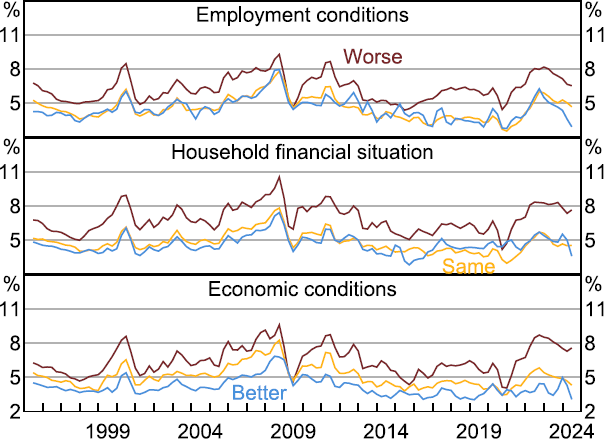
Note: Includes rounded responses.
Sources: Authors' calculations; Melbourne Institute.
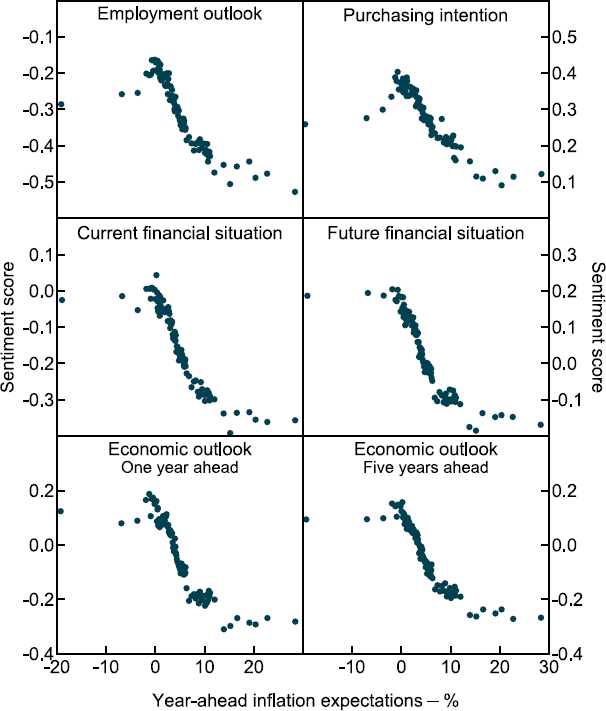
Notes: Includes rounded responses. Each panel plots a binned scatter plot of consumers' year-ahead expectations and sentiment, with those optimistic scored as 1, neutral 0 and pessimistic –1.
Sources: Authors' calculations; Melbourne Institute.
To explore these differences more concretely, we run the following regression:
where is consumer i expectation for inflation in one year's time as at time t, Xi is a number of controls for socio-economic differences, and is time fixed effects. The variables of interest Conditionsi,t are a series of questions asking the consumer about their view of the economy over the coming period, such as whether unemployment will pick up, whether economic conditions will improve or worsen, whether their financial situation will improve or worsen relative to a year ago and over the next year, or whether it is a good time to buy a large household item. We include all questions in the regression, and having separate binary dummies for ‘better’ or ‘worse’, with ‘same’ being the base case. The coefficients on these variables tell us whether positive or negative economic sentiment tends to be associated with higher or lower inflation expectations.
We again find that those expecting worse economic conditions also expect higher inflation, even once we control for potentially confounding temporal and socio-economic factors. Moreover, the finding is robust for different cohorts. While the exact magnitudes differ, the patterns are quite similar for older, middle aged and younger consumers. This suggests it does not simply reflect something about the particular historical episodes households have lived through, which has been shown to be an important determinant of people's expectations (Malmendier and Nagel 2016). Moreover, the results are also evident across the income distribution. This negative relationship is consistent with studies using data from the United States and the euro area (Kamdar 2019; Candia et al 2020).
| Full sample | Excluding rounded responses | Excluding rounded responses – by age | Excluding rounded responses High income (> $80,000) | |||
|---|---|---|---|---|---|---|
| 18–34 | 45–64 | 65+ | ||||
| Unemployment | ||||||
| More | 1.022*** | 0.427*** | 0.500*** | 0.450*** | 0.299*** | 0.365*** |
| Less | 0.008 | 0.007 | 0.041 | −0.027 | −0.032 | −0.006 |
| Economic outlook (one year ahead) | ||||||
| Good | −0.243*** | −0.142*** | −0.152*** | −0.113*** | −0.149*** | −0.100*** |
| Bad | 0.513*** | 0.181*** | 0.228*** | 0.188*** | 0.091** | 0.187*** |
| Economic outlook (five years ahead) | ||||||
| Good | −0.298*** | −0.169*** | −0.012 | −0.220*** | −0.222*** | −0.132*** |
| Bad | 0.494*** | 0.141*** | 0.199*** | 0.133*** | 0.099** | 0.144*** |
| Financial situation (one year ahead) | ||||||
| Better | 0.090*** | 0.060*** | 0.138*** | −0.002 | −0.020 | 0.070*** |
| Worse | 1.171*** | 0.637*** | 0.463*** | 0.636*** | 0.768*** | 0.610*** |
| Time to purchase large household item | ||||||
| Good | 0.047 | 0.037* | 0.264*** | −0.080*** | −0.088*** | 0.050* |
| Bad | 0.432*** | 0.142*** | 0.197*** | 0.071* | 0.103** | 0.186*** |
| R2 | 0.075 | 0.061 | 0.037 | 0.075 | 0.090 | 0.062 |
| Observations | 379,359 | 199,805 | 40,856 | 73,400 | 49,475 | 88,313 |
|
Notes: The dependent variable is households' year-ahead inflation expectations. Controls includes regional dummies, change in financial situation over last 12 months, socio-demographics (home ownership, income, education, voting preference, occupation, sex and age) and time fixed effects. Expressed relative to neutral sentiment. Regressions are unweighted. ***, ** and * denote significance at the 1, 5 and 10 per cent levels, respectively. Robust standard errors. Sources: Authors' calculations; Melbourne Institute. |
||||||
These dynamics are the opposite for wage expectations. Households that feel optimistic about the economic outlook tend, on average, to have higher wage expectations than those who expect conditions in the future to be similar or worse than they are currently (Figure 4).[2] And those individuals who expect better conditions tend to have higher wage expectations (Figure 5).
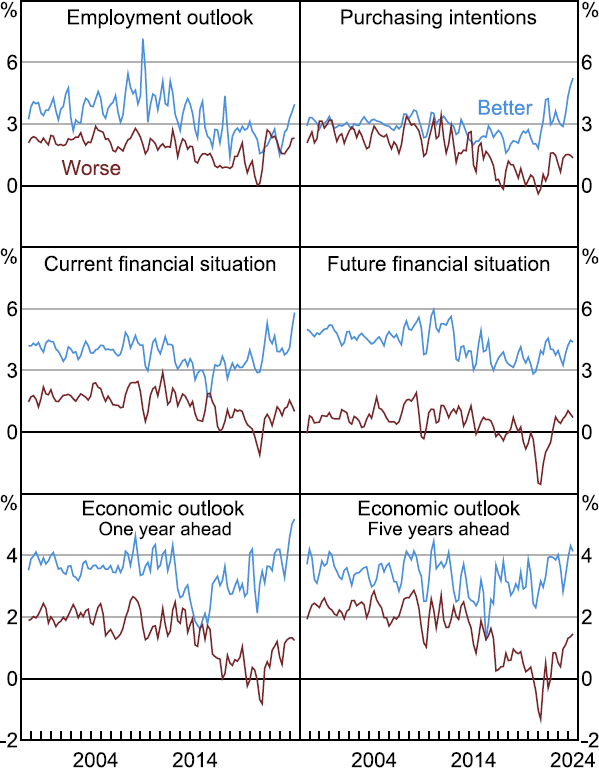
Note: Includes those expecting zero wages growth.
Sources: Authors' calculations; Melbourne Institute.
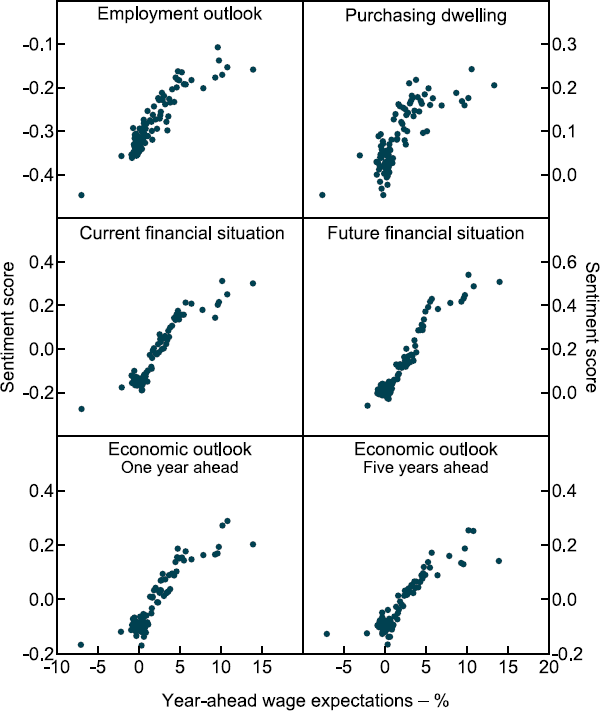
Notes: Excludes those expecting zero wages growth. Each panel plots a binned scatter plot of consumers' year-ahead wage expectations and sentiment, with those optimistic scored as 1, neutral 0 and pessimistic –1.
Sources: Authors' calculations; Melbourne Institute.
Again, this positive relationship holds once we move to the regression framework (as above but replacing inflation with wages growth) (Table 3). For example, there is a strong positive relationship between people's expectations for their financial situation and their wage growth, as might be expected. This positive relationship is again quite consistent across cohorts, though it is less evident for older cohorts, potentially as they are no longer working and so questions around their wage growth are less intuitive. Overall though, these findings are consistent with studies using data from Canada (Jain et al 2022).
| Full sample | Excluding zero wages growth | Excluding zero wages growth – by age | Excluding zero wages growth High income (> $80K) | |||
|---|---|---|---|---|---|---|
| 18–34 | 45–64 | 65+ | ||||
| Unemployment | ||||||
| More | −0.163*** | −0.405*** | −0.168 | −0.586*** | −0.179 | −0.419*** |
| Less | 0.395*** | 0.355*** | 0.513*** | 0.277* | 0.848 | 0.378*** |
| Economic outlook (one year ahead) | ||||||
| Good | 0.331*** | 0.340*** | 0.533*** | 0.152 | −0.522 | 0.388*** |
| Bad | −0.192*** | −0.334*** | −0.046 | −0.447*** | −1.016 | −0.240** |
| Economic outlook (five years ahead) | ||||||
| Good | 0.306*** | 0.341*** | 0.246 | 0.233** | 1.180* | 0.334*** |
| Bad | −0.112*** | −0.198** | −0.262 | −0.133 | −0.201 | −0.082 |
| Financial situation (one year ahead) | ||||||
| Better | 1.934*** | 2.435*** | 2.511*** | 2.391*** | 2.934*** | 2.267*** |
| Worse | −0.882*** | −2.371*** | −2.181*** | −2.498*** | −2.780*** | −2.437*** |
| Time to purchase large household item | ||||||
| Good | 0.303*** | 0.317*** | 0.403** | 0.233* | −0.515 | 0.323*** |
| Bad | −0.018 | −0.012 | 0.183 | −0.033 | −1.481* | −0.005 |
| Inflation expectations | 0.055*** | 0.113*** | 0.126*** | 0.064*** | −0.048 | 0.111*** |
| R2 | 0.071 | 0.085 | 0.075 | 0.073 | 0.112 | 0.093 |
| Observations | 165,538 | 78,356 | 23,684 | 32,178 | 2,274 | 45,999 |
|
Notes: The dependent variable is households' year-ahead wage expectations. Controls includes regional dummies, change in financial situation over last 12 months, socio-demographics (home ownership, income, education, voting preference, occupation, sex and age) and time fixed effects. Expressed relative to neutral sentiment. Regressions are unweighted. ***, ** and * denote significance at the 1, 5 and 10 per cent levels, respectively. Robust standard errors. Sources: Authors' calculations; Melbourne Institute. |
||||||
Taking these two findings together suggests that households generally associate improvements in the labour market and broader economy with higher wages growth but lower inflation. As well as being in line with Jain et al (2022), the finding is also somewhat consistent with Binetti et al (forthcoming), who find that consumers believe there are no trade-offs between inflation and economic conditions and so are resistant to the use of monetary policy to bring down inflation by weakening aggregate demand.
As discussed above, there are several potential explanations for these findings. First, it could be that households have a ‘good–bad heuristic’: they see price inflation as something bad and wage inflation as good, and so associate them with bad and good things, respectively (Kamdar 2019). It could also be that they have differing focuses on the various channels through which shocks affect outcomes. For example, they might focus on the negative effect of higher inflation on their real income (Hajdini et al 2023). Or it could reflect differing views about the nature of the shocks that drive both variables, with households tending to have a supply-side view of price inflation but a demand-side view of wage inflation (e.g. Candia et al 2020). We try to explore these explanations in more detail through the next sections.[3]
4.2 The relationship between wage and inflation expectations
As noted above, an important aspect of wage and inflation expectations is how they interact. If higher inflation outcomes or expectations feed into households' demand and expectations for wages, this can amplify the effects of economic shocks. While we cannot causally examine the relationship and pass-through between inflation and wage expectations, we can still document the reduced-form relationships in the survey. We focus on the contemporaneous relationship between inflation and wage expectations, rather than any medium-term relationships. It is possible that this may miss some pass-through if it is gradual, for example, due to differing price-setting rigidities. But given the data are a repeated cross-section and not a panel, we focus on contemporaneous relationship.
Focusing first on the aggregate time series (Figure 6), there is a moderate positive relationship between households' year-ahead wage expectations and their inflation expectations, with the two having a correlation of 0.5. This is also true of wage expectations and inflation perceptions.[4] There is also a relationship when we focus on consumer-level results (Figure 7). That said, the magnitudes suggest relatively low pass-through: the slope of a line of best fit from the individual-level scatter plots suggests a 1 percentage point increase in inflation perceptions or expectations passes through to only around an 0.1 percentage point rise in wage expectations.
This finding of low pass-through is also evident if we use a regression framework, controlling for time and other effects and focusing in on person-level variation in both variables (Table 3). Specifically, when incorporating inflation expectations into the above wage expectations regression, the coefficient on inflation expectations is very small at around 0.05–0.1. So, a 1 percentage point rise in inflation expectations would only be associated with a 0.05–0.1 percentage point rise in wage expectations.
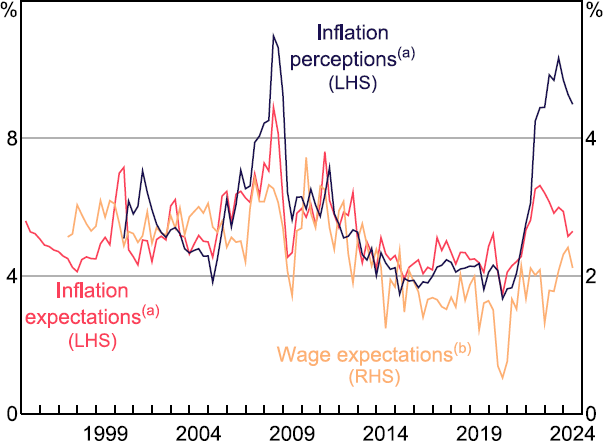
Notes:
(a) Includes rounded responses.
(b) Includes those expecting zero wages growth.
Sources: Authors' calculations; Melbourne Institute.
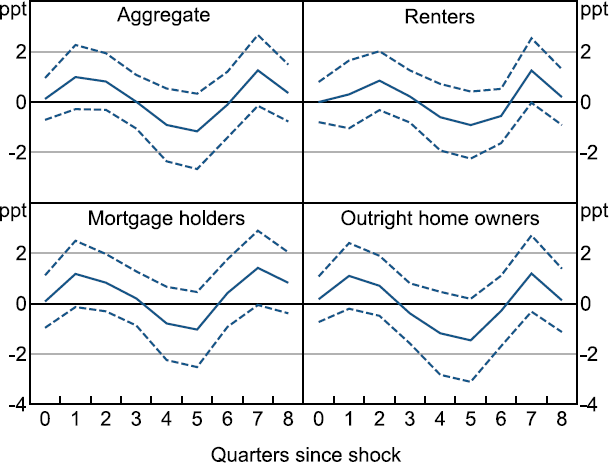
Notes: Excludes those expecting zero wages growth or zero inflation. Each panel plots a binned scatter plot. Line is line of best fit.
Sources: Authors' calculations; Melbourne Institute.
These findings are perhaps unsurprising given the earlier findings that suggest households have quite different views of the correlates of inflation and wage growth. They are also consistent with Jain et al (2022) and Hajdini et al (2023), who also find a small but positive pass-through from inflation expectations to expected wages growth for households in Canada and the United States respectively, and Savignac et al (2021) who find similar for firms in France. While we need to be careful about interpretation as our results are correlations, rather than causal, they do provide some evidence that there may be relatively limited direct feedback from households' inflation expectations and perceptions to their wage expectation, which could limit the scope for amplification of supply shocks through such a mechanism.[5]
That said, there are a number of other potential explanations for these findings that should temper these conclusions. For example, if supply shocks are a key driver of expectations, the natural divergence between inflation and conditions could bias down our estimate of the causal pass-through between inflation and wage expectations. Similarly, the pass-through may be gradual due to differing rigidities in price and wage setting, and our contemporaneous approach to measurement may miss this.
Footnotes
This is the case for all questions related to sentiment in the survey, including employment, personal financial situation, spending (both household items and dwellings) and the general economic outlook. [2]
An alternative explanation could be that households believe that technology shocks are important economic drivers. Such shocks can cause inflation and wages to move in different directions, depending on the model of the economy one uses. However, given the ambiguity inherent in such shocks' effects, this belief seems somewhat unlikely. [3]
The correlation is about 0.4–0.5 when looking at year-ended changes but materially smaller for quarterly changes. [4]
While our results are not causal, Savignac et al (2021) and Hajdini et al (2023) use plausibly causal experimental set-ups to generate their findings. [5]